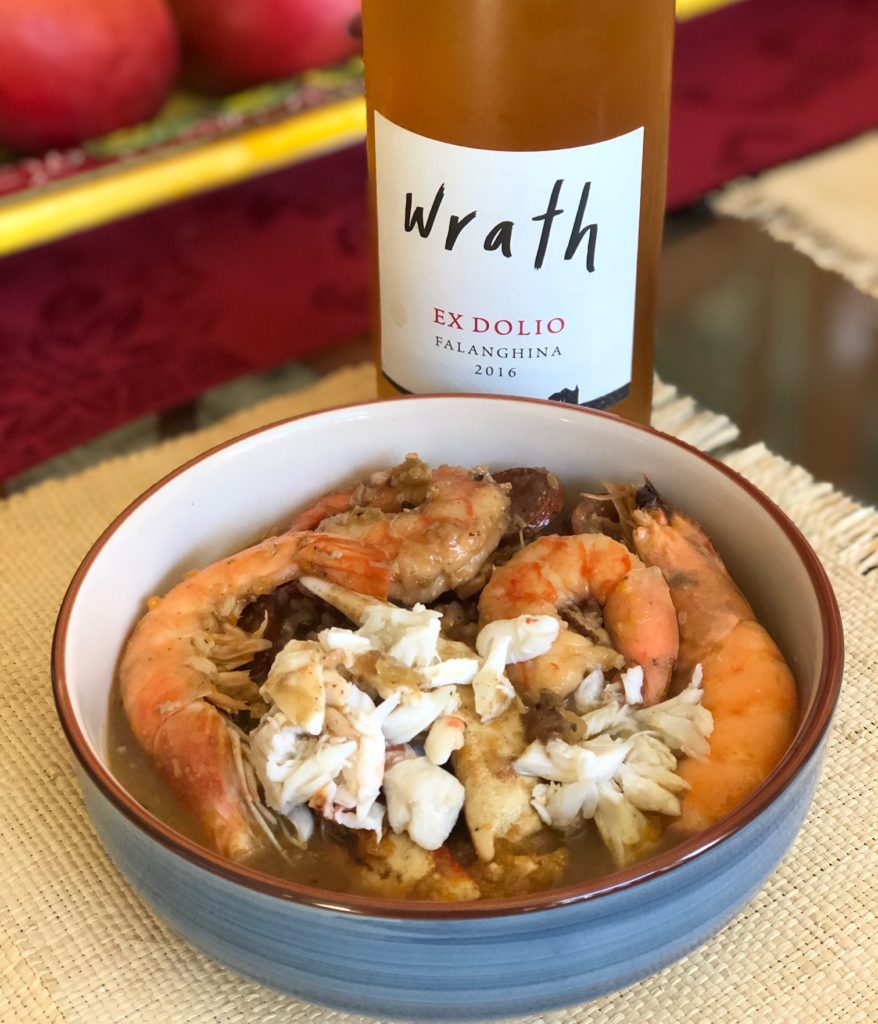I salute the winemakers who are making rut-busting wines from lesser known grape varieties. You should too. Now get out there and taste something new!
This month, inspired by Jason Wilson’s book Godforsaken Grapes: A Slightly Tipsy Journey Through the World of Strange, Obscure, and Underappreciated Wine, the Wine Pairing Weekend (#WinePW) group of bloggers are focused on food pairings with wines made from lesser known (dare I say obscure!) grape varieties.
There are nearly 1,400 known varieties of wine grapes in the world—from altesse to zierfandler—but 80 percent of the wine we drink is made from only 20 grapes”
Jason Wilson
I’d venture to say that California leads the way when it comes to making wines from lesser known grape varieties. I believe that’s because of the combination of the state’s glorious weather and its pioneering spirit.
I discovered this for myself when I attended attended a few ” Seven% Solution” tastings. According its organizers, 93% of the vineyards in the North Coast appellation (which includes all of Sonoma, Napa, and Mendocino Counties) are planted to just 8 grapes. The hundreds of other grape varieties grown in California make up the other seven percent.
While its well known that California boasts a predominately Mediterranean climate, what can get overlooked is its geographic diversity. There are a wealth of terroir influences from the Pacific Ocean to the west and the Sierra Mountains to the east. The state is replete with micro climates which produce a remarkably diverse palette of grape varieties for its winemakers.
In terms of the number of grape varieties grown in California’s wine regions, a quick Google Search turned up the following:
- Napa Valley – 36
- Paso Robles – 40
- Sonoma – 50
- Lodi – over 100!
In My Glass And On My Plate
Disclosure: I received these wines as a media samples. I received no compensation for this post, and all opinions presented are my own.
Courtesy of Big Bang Wine and Sip Certified, I had a couple of wines which fit the bill for this month’s theme perfectly:
- 2016 Wrath Falanghina Ex Dolio from the Monterey AVA
- 2016 J. Wilkes Lagrein from the Paso Robles AVA
2016 Wrath Falanghina Ex Dolio
Falanghina is an ancient Italian white-wine grape that is native to the Campania region is Southern Italy. It is believed to be of Greek origin. There has been a renaissance of interest in Falanghina since the turn of the century, and there is now a movement to restore the reputation of this once-venerated grape. In Campania, it thrives in the porous volcanic soils around Mount Vesuvius and the warm Mediterranean climate. Scant amount of the grape are grown outside of Italy.
The 2016 Wrath Ex Dolio Falanghina comes from the two rows of vines on their estate vineyard, situated in a sheltered nook just below the Santa Lucia Highlands AVA. This is an orange” wine (a.k.a. skin fermented white) which was fermented on the skins in a dolium (the modern version of an ancient clay fermenting vessel) until dry, then racked off and placed back into the dolium for 6 months of aging. It’s unfiltered and unfined.

My tasting notes follow:
Cloudy golden-orange color with apricot, lanolin, savory spice aromas, and a kiss of wet stone aromas. On the palate it’s medium-bodied and dry with vibrant, refreshing acidity and a hint of tannins with ripe apple, dried apricot, lemon, and baking spice flavors with a very satisfying mineral laced finish. 13.2% abv|SRP-$29|92 cases produced|90pts.
Seafood is Falanghina’s best friend. I paired this with my homemade Seafood Gumbo, it paired especially well with its crab and shrimp.
2016 J.Wilkes Lagrein
Lagrein is an ancient grape variety that finds its home in the sunny vineyards of Trentino-Alto Adige in northeastern Italy. Its wines are strong and full bodied with plum and wild cherry flavors, and the variety is particularly well known for the deep, dense color it imparts on wines. Lagrein has a characteristically north-Italian fresh, acidic structure and a slightly astringent finish, making it best paired with food. When made well, Lagrein wines can offer an off-the-beaten-path alternative to full-bodied wines like those made from Cabernet Sauvignon. The best examples can be aged for several years, although they are best drunk within a few years of harvest according to Wine-Searcher.com.
The J. Wilkes brand is named for Jeff Wilkes. After a long and rewarding career as salesman, grape grower and ambassador for Santa Maria and Paso Robles wine, he decided to try his hand at winemaking. He went to his long time employer and friend, Steve Miller, with a proposal to create wines that focused on California’s Central Coast, through the lens of two of its sub-AVA’s (American Viticultural Areas) – Santa Maria and Paso Robles Highlands. He launched his ‘J.Wilkes’ label in 2001, focusing on Santa Maria Valley Pinot Noir, Pinot Blanc and Chardonnay, and made his last wine in 2010 before his untimely passing late in that same year.

Pair Lagrein with hearty dishes traditionally served during winter months. Any dish that might be served with Chianti or Valpolicella would work just as well with a Lagrein.
My tasting notes follow:
Inky purple with low key dark fruit, earth, crushed gravel On the palate it’s medium-bodied, rich and fresh with firm, rustic tannins and black raspberry, black cherry, and black plum flavor underscored with an appealing minerality and a medium finish.
Paso Robles- Highland District|14.5% abv|SRP – $30|88pts.
These were two very good to outstanding wines offering very good value that I would welcome in my glass anytime!
I salute the winemakers who are making rut-busting wines from lesser known grape varieties. You should too. Now get out there and taste something new!
Be sure to check out the very diverse selection of lesser known grape varieties and food pairing served up by my fellow Wine Pairing Weekend blogging pals below:
- A North Macedonian Blend: Vranec and Plavec by My Full Wine Glass
- An Ode to Godforsaken Grapes on Somm’s Table
- An Unlikely Match: A Thai Favorite + A Qvevri-Aged Wine from the Republic of Georgia by Culinary Adventures with Camilla
- Cesanese, Schioppettino and More Interesting Wine to Try by Cooking Chat
- Godforsaken Grapes: The Book and Thoughts about Wine by Our Good Life
- Godforsaken Grapes: The Book, The Wine, The Pairing by A Day in the Life on the Farm
- Pairing Blaufrankisch from Austria with Dark Soya MarinatedChicken Legs by Chinese Food and Wine Pairings
- Pair Petit Manseng with Asian Food by Asian Test Kitchen
- Pairing the Unpairable: Traditional Turkish Manti and Yogurt with Öküzgözü Rosé by The Quirky Cork
- Saperavi is Super with Khachapuri by Dracaena Wines
- Southwest France: A Pool of Grape Diversity by L’Occasion
- Tasting & Pairing Tannat – #WinePW Exploration of Godforsaken Grapes by The Corkscrew Concierge
- To Try in 2020: Paso Whites– Unexpected Grapes In anUnexpected Region by Wine Predator
- The Forgotten Grapes of Calabria: Gaglioppo of Ceraudo with Salsiccia by Vino Travels
- White Port: A Blend of Grape Varieties Unknown to Many by Grape Experiences
If you’re reading this earlier enough, please join out Twitter chat on Saturday, January 11th at 8a Pacific. Just follow the #winepw hashtag
About SIP Certified
SIP Certified is one of the wine industry’s oldest and most important organizations to promote sustainable winegrowing and winemaking. They also encourage the ethical treatment of their employees and the well being of neighbors and neighborhoods. It’s pilot program commenced in 2008 with 3,700 acres of vines between Monterey and Santa Barbara counties. Today, there are 43,600 acres of vines in California and Michigan and more than 36 million bottles of wine that have been SIP Certified. This ensures that conscientious consumers across the country can enjoy wines that have been grown sustainably for the greater good.

While you’ll find SIP Certified wines that are also organic and biodynamic, the SIP Certified process addresses additional farming methods, looking at sustainable practices on every level, from farm labor to agriculture – from energy conservation to water quality. It is an additional way for consumers to know they’re buying sustainable wines that give back to the land and community on every level.
________________________________________________________________________
Follow me on Twitter, Facebook, Instagram, Vivino and for all things wine. As a wino with latent foodie tendencies, you’ll also find plenty of food and wine pairings, and wine related travel stuff! Become a fan and join ENOFYLZ Wine Blog on Facebook. Cheers!
Copyright Notice: This entire site is Copyrighted 2010-2020. All Rights Reserved. No unauthorized copying of any section of this site is permitted. If you wish to use any part of this site, contact me. For information on Copyright Law, see the official U.S. Copyright Office home page.
You two know how to eat, that gumbo! Mark and I are fans of both these varieties but have yet to taste US versions. Next time you visit, bring them! I’ll supply the Italian versions and we’ll have some fun! (Or vise versa 😉
Thanks for joining in this month, Martin. The wine and your pairings sound delicious. I am embarrassed to admit that I had no idea that Wrath was making Falanghina. They are in my neck of the woods, so I will remedy that oversight soon. Cheers.
I love that you showcased wines from California. It betters my odds of finding them here in Michigan.
I love that these varieties are planted in California! Would be interesting to drink side by side with wines from their original origin.
I have had Wrath wines before, but not their Falanghina. I am a fan of the grape, so am going to seek this out!
Love this post Martin and love the concept of trying lesser known and/or underappreciated wines. We discovered a Lagrein in Oregon a few years back and i don’t think i’d seen it in the US up until this article. Thanks for continuing to inspire us to drink different!
What a fantastic selection of wines! Can’t imagine an orange falanghina but I might be more jealous of that homemade seafood gumbo. Yumm!!!
Ah. A fellow Seafood Gumbo lover. Yah. I make my own every year for NY Day! Do you ever make Deanna?
Martin, isn’t Wes Hagen the winemaker for J Wilkes now? I used to love his wines at Clos Pepe!
Great post😀
Thanks so much!
Love to see grapes like this being made in California. Will keep an eye out for these.
CA such a great place to grow a wide variety of grapes. It’s great to see so winemakers embracing lesser known grape varieties!
Although I try a lot of different grape varietals, when it comes to California I am typically having the more usual suspects. I need to look for opportunities to change that up, motivated by reading this!
Thanks David. California has such great weather and so many microclimates. It really is a great place to grow grapes. It’s great to see winemakers embrace the lesser known grape varieties!
Love your phrase, “rut-busting,” for these lesser-known grapes. Enjoyed your post about these two grape immigrants to Cali!
Thank you for the kind words Linda! Much appreciated!
What interesting wine varietals, and I can’t believe they’re from CA! I really wish these wines weren’t so hard to find, but I guess the search and visits to local tasting rooms just makes it that much more fun. 🙂 Great recommendations and examples of CA godforsaken grapes!
Thanks so much for the kind words Deanna! Cheers!
You always seem to discover a lot of Italian grapes in California. Loved reading about these. Some interesting facts how there are so many grapes, but a limited amount dominate the production numbers. I love having days like these where we open eyes to other opportunities out there.
Agreed! I love these types of themes! Cheers Jen!